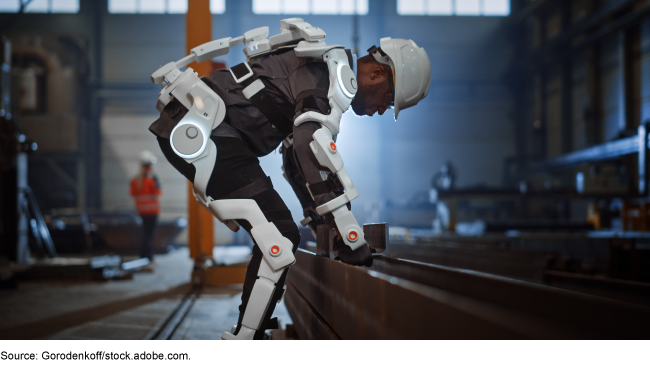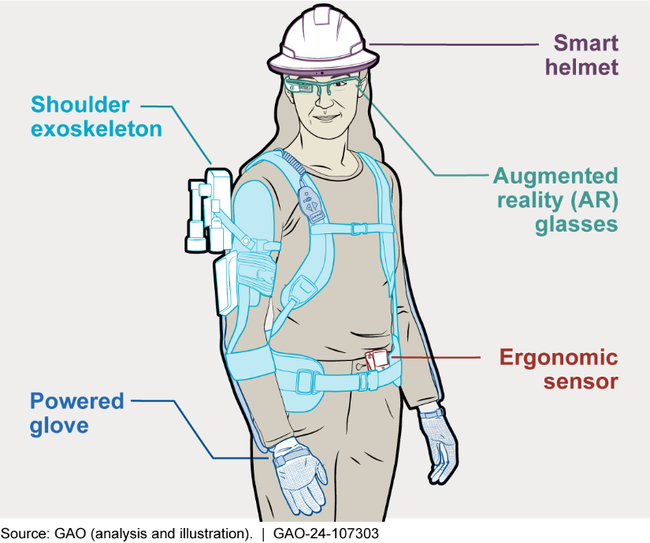Science & Tech Spotlight: Wearable Technologies in the Workplace
Fast Facts
In 2022, workers in warehousing, manufacturing, and construction experienced over 700,000 nonfatal injuries and over 2,000 fatal accidents. This Spotlight discusses how companies are deploying technologies worn on the body to try to improve safety and productivity.
These wearable technologies vary in size and function. Technologies such as exoskeletons—which can provide physical support to the user's body during repetitive overhead work—are already in use in industrial workplaces.
But concerns about data privacy, cost, and ease of use may deter adoption of wearables. For example, employees have had concerns about being tracked by the devices.
Person using an exoskeleton to work

Highlights
Why This Matters
In 2022, the warehousing, manufacturing, and construction industries experienced over 700,000 nonfatal injuries and over 2,000 fatal accidents. Meanwhile, consumer demand on these industries grows, creating pressure for increased productivity. To enhance and monitor worker safety and productivity, companies have begun deploying wearable technologies, from ergonomic sensors to exoskeletons.
Key Takeaways
- Recent innovations in sensor and networking technologies have increased the feasibility of and interest in the use of wearables in the workplace.
- Companies have already deployed some wearables, but there are limited published data on the efficacy of these technologies to increase safety in the workplace.
- Concerns about data privacy, cost, and ease of use may hinder widespread workplace adoption of wearables.
The Technology
What is it? Wearable technologies, or wearables, are devices worn on the body and can vary in size, shape, and function. Some employers have an increasing interest in using wearables to improve worker safety and productivity. Industrial uses fall into four general categories: (1) supporting devices physically assist workers with tasks like lifting (e.g., exoskeletons and powered gloves); (2) monitoring devices alert workers to specific changes in vital signs or the workplace environment (e.g., smart helmets); (3) training devices provide feedback on movements (e.g., ergonomic sensors) or help improve worker performance (e.g., augmented reality (AR) glasses); and (4) tracking devices observe the location of employees on a worksite (e.g., GPS trackers). See figure 1 for examples.

Figure 1. Illustration of some wearable technologies of interest to modern industrial workplaces.
How does it work? The way wearables work depends on the type of technology.
Supporting devices like exoskeletons or powered gloves provide physicalsupport to the user’s shoulders, hands, or back during repetitive overhead work, gripping, or lifting.
Most monitoring, training, and tracking technologies take advantage of innovations in networking by connecting many types of sensors to collect, exchange, and analyze data—sometimes referred to as the industrial internet of things (IIOT). Smart helmets, for example,incorporate physiological and environmental sensors and GPS trackers into protective headgear. These sensors can alert employees and workplace medical teams to accidents, such as falls, and to potential hazards, like heat and humidity. Similarly, ergonomic sensors, worn on the hip, back, or arm, can alert a user when they perform potentially unsafe movements (e.g., lifting with improper form). Through real-time alerts and movement data analytics, these sensors may help train workers and reduce injuries.
How mature is it? Advancements in sensors, data analytics, and networking technologies have increased the feasibility of wearables, although their maturity varies. Several companies use exoskeletons or ergonomic sensors to some extent. Other wearables, such as smart helmets, have had pilot studies but still need further testing. Battery life and accuracy of underlying location tracking technologies pose challenges for scale-up.
Recent studies have drawn limited conclusions in assessing the net effect of wearables on employee health and productivity. For example, one peer reviewed study showed that ergonomic sensors may reduce time in risky postures, but the study had limitations including a small sample size and short duration. A different review of wearables points out that the pressure of being constantly monitored can lead to increased stress in some workers and, consequently, increased probability of injury.
Opportunities
- Improve employee safety. Wearables could reduce the risk of injuries from strenuous work or worker-equipment collisions and may improve response time to emergencies.
- Increase employee productivity. Some companies have used AR glasses to aid repair technicians or to reduce error rates when item picking to fill orders.
Challenges
- Privacy. Monitoring devices can store data on employee physiology and movements, which may create privacy concerns. For example, employees surveyed as a part of a wearable pilot test cited concerns about being tracked.;
- Data Security. Data stored on wearables may be vulnerable to hackers because updating software can be difficult and many devices lack strong encryptions.
- Cost. Companies can face high up-front costs to acquire and deploy wearables.
- Ease of use. Employees may find some technologies cumbersome, complex, or uncomfortable to use. For example, one study cited employee concerns about the additional weight of the wearable.
Policy Context and Questions
The National Institute for Occupational Safety and Health (NIOSH) conducts and coordinates research on wearables. Officials from the Occupational Safety and Health Administration (OSHA) told us that the agency oversees workplace safety but does not have any specific standards related to wearables.
- What types of additional studies would determine whether wearables achieve benefits such as improving employee safety?
- What is the federal role, if any, in overseeing these technologies and their use in the workplace?
- What safeguards or standards, if any, could help ensure that the development and adoption of wearables achieves positive outcomes and responds to employee concerns?
Selected GAO Work
Workplace Safety and Health: Actions Needed to Improve Reporting of Summary Injury and Illness Data, GAO-21-122.
Internet of Things: Status and implications of an increasingly connected world, GAO-17-75.
Selected References
"Wearable Technologies" NIOSH Science Blog, https://blogs.cdc.gov/niosh-science-blog/category/wearable-technologies/. Accessed January 29, 2024.
Ekaterina Svertoka, et al., “Wearables for Industrial Work Safety: A Survey,” Sensors,vol. 21 (2021) doi:10.3390/s21113844.
For more information, contact Karen L. Howard, PhD at (202) 512-6888 or howardk@gao.gov.
